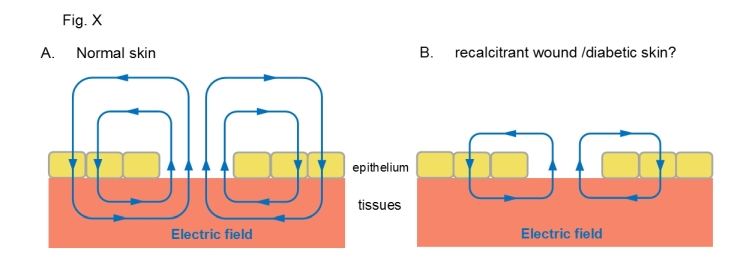Regenerative medicine strategies aim to facilitate the healing processes, or provide replacements for diseased or damaged tissues1.
Recalcitrant wounds are ones that are exceptionally difficult to heal, often progressing to become life threatening. There is also a growing prevalence of such wounds:
- One in five in-patients in European hospitals have a pressure ulcer2.
- 15% of diabetic foot ulcers resulting in amputation3.
- Ie an amputation each 30 s worldwide4.
- This in turn leads to over 50% mortality within 5 years5.
Compared with normal skin wounds, the diabetic skin, aged normal skin and recalcitrant wounds exhibit a diminished electric field and associated wound current, which could explain the impaired wound healing in these various patients.
A central feature during regeneration is the re-instigation of the natural electric field patterns previously occurring during morphogenesis. Applied electric fields are one of the very few strategies that have met with proven success in improving the healing rate of recalcitrant wounds, and in coaxing regeneration in organisms which do not normally regenerate.
Proposed model of electric field during wound healing in normal skin compared with diabetic skin and wounds recalcitrant to healing. Therapeutic interventions could then target and normalize impaired specific ion fluxes that underlie these effects1.

Reference 1. Tyler SEB (2017) Nature’s Electric Potential: A Systematic Review of the Role of Bioelectricity in Wound Healing and Regenerative Processes in Animals, Humans, and Plants. Front. Physiol. 8:627. doi: 10.3389/fphys.2017.00627
Further references
2. Martin-Granados, C., and McCaig, C. D. (2014). Harnessing the electric spark of life to cure skin wounds. Adv. Wound Care
3. 127–138. doi: 10.1089/wound.2013.0451 3. Posnett, J., and Franks, P. J. (2008). The burden of chronic wounds in the UK. Diabetic Med. 14, S7–S85.
4. Richard, J. L., and Schuldiner, S. (2008). Épidémiologie du pied diabétique [Epidemiology of diabetic foot problems]. Rev. Med. Interne 29(Suppl. 2), S222–S230. doi: 10.1016/S0248-8663(08)73949-3
5. Reiber, G. E., Boyko, E. J., and Smith, D. G. (1995). Lower extremity foot ulcers and amputations in diabetes. Diabetes Am. 2, 409–427.